Wa’a, Source of Ancient Wisdom, Sailing to the Future
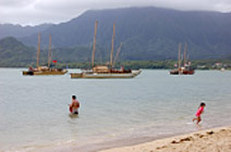
The recent arrival of seven voyaging canoes from the South Pacific, (see: http://pvs.kcc.hawaii.edu), highlights this increasing reconnection with ancient knowledge and wisdom and a new solidarity between Pacific Islanders. This tremendous effort was made possible through many smaller efforts, just as the renaissance of Hawaiian Culture has come about through the efforts of many individuals joining their energies to perpetuate a path that will sustain future generations.
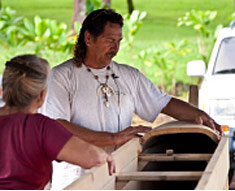
The story of this canoe began in New Zealand, the point of origination of 8 rare New Zealand or Kauri pine seedlings planted at the state arboretum in Hilo and also the point of origin of one of the seven recently arrived voyaging canoes. The source of the log for the canoe is owed to the serendipitous aloha forces always at work here. Just as characters can sometimes be in search of an author, a very special log was in search of a canoe builder. “Three years ago just before I started this they had a storm and one of the trees fell over and they said it was termite eaten…. so they had this one guy cut all the trees down and the last one they cut down was this one, didn’t have termites. And just so happened they had something for Obama, a rally in Hilo and Steve went, Hirakami he’s the head master of the school. When he went he met the guy who cut em down, that’s his good friend. So they was talking and by the time they left there he told him that they had this log sitting over there and he told him that if he wanted they were going to donate it to the school and he called me the next day and he asked me if I wanted to work the canoe. I said, "Sure!”
Kimo’s canoe building life began on O’ahu, but was soon to take him all over the Pacific and the Hawaiian Islands. Kimo and his five siblings grew up in Honolulu, “Right there on the ocean in Kulio’o. So we always surfing, paddling canoe from 9 year-old, 10 year-old.” His early experience with canoe building was with master builder, Wright Bowman. “I knew Mr. Bowman from when I was 9 or 10. He was always a canoe builder from when I was a small kid.” Then at the age of 15 Kimo met his destiny when Puaniho Tauotaha entered his life. “I learned to make canoes from my hanai father from Tahiti. From when I was 15 I started working. From then on I just chucked it all in and worked on canoes.” This began an odyssey throughout the Hawaiian Islands and Tahiti. “From then on I traveled all around the Islands with him and Tahiti building canoes...He told me he built over three or four hundred canoes.”
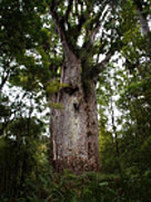
Ancient knowledge handed down through the generations was closely guarded. Kimo was the only person outside the ‘ohana to which Tauotaha passed on canoe building knowledge. “He didn’t teach anybody outside of his family besides me for building canoes. Lot of times we would be working and people would come around to see how he was doing stuff, he’d stop working and we’d just sit there and talk story until they left. Then we go back to work.”
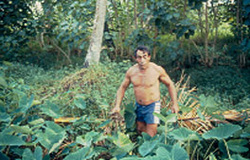
In the Hawaiian Islands, Kimo and Puaniho built racing canoes for various island clubs. “Mostly we did all racing canoes in Hawaii. Kauai, Lanai, up on the Big Island, we did for Kaupua, Hui Nalu in Honolulu. We did canoes up for Kalapana. Then we went to Maui. So pretty much all the islands we touched and went around.”
The project on Maui proved to be a bit more challenging. “The one in Maui was an old canoe John Lake built in the 30’s. By the time we went over there in the 80’s it was in disrepair. Had only like the bottom part of the canoe. Everything else was all rotten and we went and built it back up from scratch. It only looked like one feed trough when we started. From there we finished it just like this to the end and they’re racing it today for Maui for the Hawaiian Canoe Club.” The challenge was patching together the sides and the bottom. “All glues, just glue. We got one patching machine. I swear one side had about 200 patches. But when we finished was all good. The manu (the piece that covers the front and back of the canoe) for the canoe, the front and back manu comes from Kalapana, from the log we used to build the canoe for Kalapana. We brought em over there and we put em on. Was nice.”
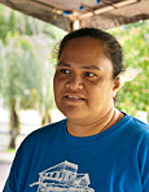
Because the log was already in place, Kimo’s first task was to examine it to decide which side would be the bottom. After the bottom of the canoe is identified, a sort of sculpting process begins. “The first thing we did was the top. We cut off the top. And then we drew the lines for the sides. Then as soon as we got the lines for the side that was the second thing to come off. Once we got the sides off we tip it on the side and we did the bottom to get the shape we wanted. We shaped the bottom with hand planers, electric planers.”
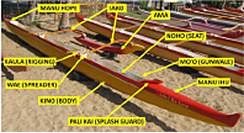
Kimo wanted the canoe to be one solid piece so he had to work with the dimensions of the log. It’s “not actually a racing canoe. It was short yeah. Usually for a racing canoe it’s 45 feet long. This one is 32 feet [so] I only made it for 5 man.” That way the paddlers have room and will avoid hitting each other and there will be room for an extra paddle. “Number 5 has room for seating and then they can put an extra steering paddle in back. Cause usually if the paddle breaks the steersman has an extra paddle in back or either that or he gonna take the one in front of him. Somebody got to steer. If they’re racing or doing long distance they got extra paddles one on each of the iako.”
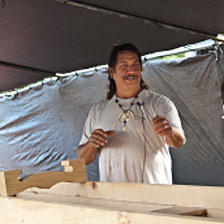
The name for the HAAS canoe, Hana Ka Naia (working dolphin), seemed to be a whisper from the canoe itself and the magic surrounding its creation. “You just talk to the tutus and talk to the spirits. I just asked my tutus and that name came to me. I went to talk to Steve and I said, ‘Hey Steve, when I finished the manu, I’m going to put the iwa birds on the back and on the front manu I’m going to put a couple dolphins.’ Every time you’re on the ocean in boats, dolphins are always in front and if you look in the sky you always got the iwa above.”
The vital tradition of the canoe is being kept alive and growing throughout the Pacific, through the efforts of people like Kimo who give of themselves to the keiki, the ‘aina and the Akua, whose presence preserves and protects the culture that connects all the islands of the Pacific. “I’ve been doing other things for awhile but first was the canoes. I want to get back to the canoe. I want to try and make a project and go to the schools and teach all the kids how to build them. If they want to learn our culture, that’s our culture, was based on the canoe. How we came to Hawaii was the canoe. For our whole culture the canoe was the first.”
 RSS Feed
RSS Feed
